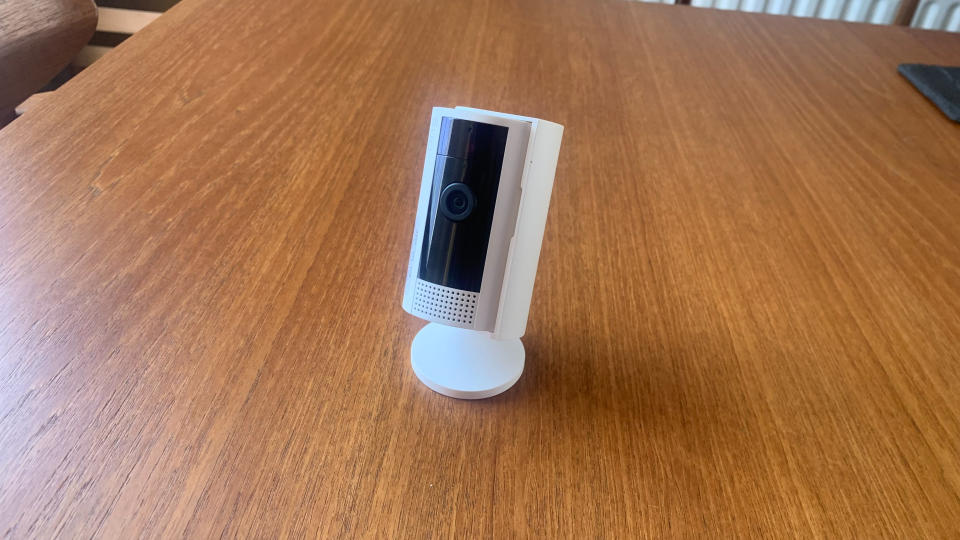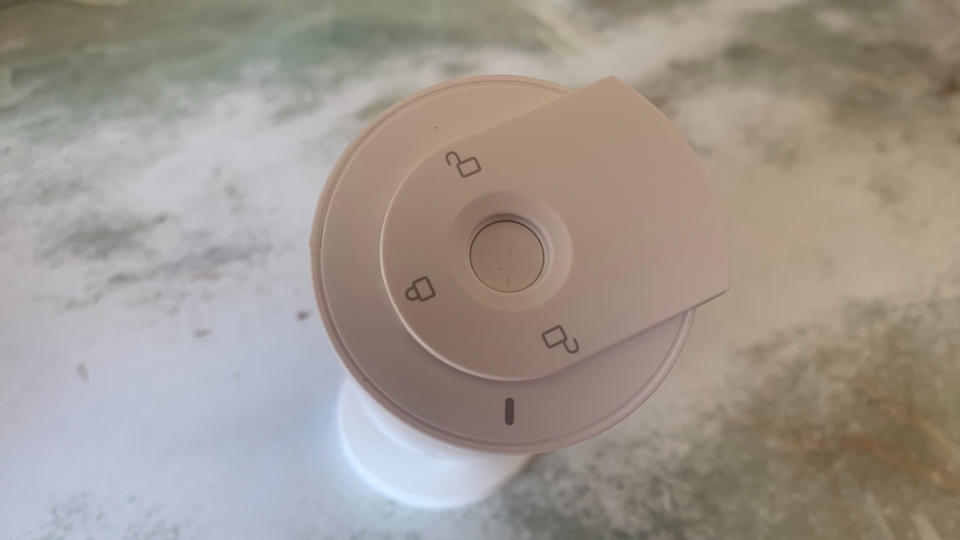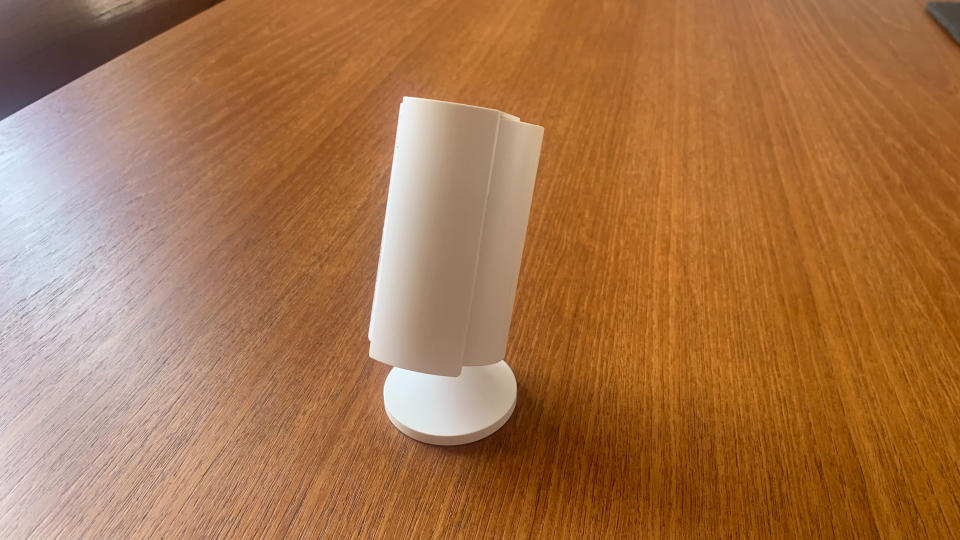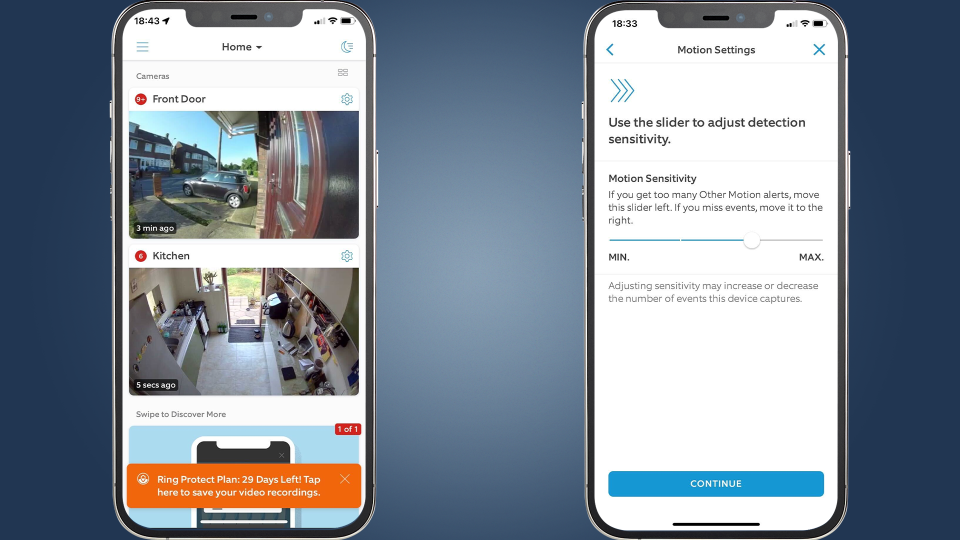Ring Indoor Cam (2nd gen) review: new privacy shield, but fairly unchanged

One-minute review
Ring’s 2023 upgrade to its Indoor Cam brings a few changes to its exterior, but in general remains the same – which isn’t a bad thing.
It isn’t too surprising that the differences between the first and second-generation cameras are minimal and iterative. In our review of the original Ring Indoor Cam, we awarded it 4.5 stars; however, note that some of the features that helped it to gain that score – namely, the Home/Away modes – are no longer available as a standard with either the first or second generation Ring Indoor Cam. Still, it's undoubtedly one of the best home security cameras available.
Ring rose to prominence with its gold standard video doorbells, which have gone from strength to strength in recent years. However, it’s fair to say that the subscription fees that gate-keep many of the best Ring features cloud opinion. Much the same can be said of the Ring Indoor Cam – although pretty affordable to start, you don’t get access to the security features that best justify setting up an indoor security camera without having a Ring Protect subscription.
Still, the Ring Indoor Cam (Gen 2) has plenty going for it, even if we’d have liked to see some more hardware improvements – better resolution, for example.

Ring Indoor Cam (Gen 2) review: price and availability
List price: $59.99 / £49
Available on Amazon, Ring and through other third-party retailers.
Released in 2023, the Ring Indoor Cam (Gen 2) is a 1:1 replacement for the original camera, with the latter only now available through a few third-party retailers.
The Ring Indoor Cam (Gen 2) is priced identically to the first-generation indoor camera, and reasonably against the competition – although you’ll have to factor in the Ring Protect subscription costs, if you really want to make it worth the money. Prices for the Basic plan starts at $4 / £3.49 / AU$4.95 per month, or $40 / £34.99 / AU$49.95 per year, and cover one device. Depending on your location, there are other options available. The Plus membership is almost double the price and covers multiple devices, while the Pro plan (currently available in the US only) starts at $20/month or $200/year.
Value: 4/5
Ring Indoor Cam (Gen 2) review: specifications

Ring Indoor Cam (Gen 2) review: design
New ball joint plate
New privacy cover
Easier mounting plate
Measuring a petite 4.9 x 4.9 x 9.6cm, the second-generation Ring Indoor Cam is just a touch larger than its predecessor, which is the result of the ball joint plate and privacy cover. It’s still compact, though, and will be pretty inconspicuous in the home.
Elsewhere, the camera housing is identical to the previous model; it’s a cylindrical, plastic case with a black panel that’s home to the camera.
The ball joint is pretty fluid, for a far greater range of motion, and more placement options, including even a birds-eye view. I opted to place my review unit above my kitchen door, facing the back door, so I could spy on my cat as he comes and goes. The mounting plate was a little difficult to get off, but with this done, affixing the camera to the door proved super easy. There are no raw plugs included for tidying up the wire, which is a small but slightly annoying oversight.
The new privacy cover, which silences the mic and video feed, is a little clattery and tacky feeling, but it does the job really nicely and offers enough resistance that it doesn’t feel loose.
Like the previous generation, this camera is wired-only, which means it will need to be positioned near a power supply. The camera charges via a USB-A cable, which plugs into a recessed port on the rear of the camera.
Design: 4.5/5

Ring Indoor Cam (Gen 2) review: performance
Easy to set up
Many features hidden behind subscription
No major performance upgrades
After a very quick and easy setup, which took about 10 minutes from unboxing to mounting and pairing, you’re all set to start monitoring your home with the Ring Indoor Cam.
In the companion app, you can customize your settings. As well as alert settings, you can map out Privacy Zones and Motion Zones, which ensure the camera is only recording what needs to be caught on film. You can also tap into the camera’s live view from the app, which in my experience worked reliably with little lag.
The camera has a respectable 143° diagonal field of view, which still stands out among peers at a similar price point. However, while 1080p HD resolution is standard among the first-generation Ring Indoor Cam’s peers, some newer products are starting to up the ante to 2K. Given that we’re now unlikely to see another Ring Indoor Cam for at least a couple of years, this feels like a wasted opportunity. Still, in terms of performance, the resolution and color vision just about hold up. The two-way audio works well, and while the speaker and pickup quality won’t see you recording any podcasts via Ring, they’re loud and clear enough to understand.
It’s not all old news, though; the Ring Indoor Cam does now come with the pre-roll feature we’ve seen on other Ring devices, which captures the video feed of the few seconds before a recording trigger.
In theory, the privacy cover appears to be great news for guarding privacy around the home, but in practice it’s a little annoying. While I can forgive its slightly cheap feel given the camera’s list price, it isn’t at all practical if you want to affix your camera high up – which many will – and don’t want to stand on a chair to change it every time you come and go. My solution was to unplug the whole device when at home. I can understand the reason Ring went down this route, but I’d recommend just buying a smart plug and automating it to turn on/off when you’re home.

Overall, if you’re looking for a simple yet capable indoor camera, the Ring Indoor Cam will deliver – with or without the subscription. However, in my opinion, the Ring Indoor Cam (Gen 2) just doesn’t feel quite as exciting as the original, and much of that comes down to the fact that so many of the features are now gated behind a Ring Protect subscription.
From Home and Away modes (which used to be free) to storage, People Only mode to more detailed notifications, the Ring Indoor Cam with a Ring Protect subscription offers so much extra. Personally, I’d rather Ring invested money into the hardware and design, upping the list price as a result, but reducing the dependency on long-term subscriptions to break even.
That being said, there’s one thing for sure; both the included and subscription-based features work very well, and reliably so. Plus, the app is very intuitive and easy to navigate while you customize your motion and notification settings. For what it’s worth, the Ring Indoor Cam does deliver.
Performance: 4/5
Should I buy the Ring Indoor Cam (Gen 2)?
Buy it if...
Don't buy it if...
Ring Indoor Cam (Gen 2) review: Also consider
Decided against the Ring Indoor Cam (Gen 2)? Why not check out these alternatives...
How I tested the Ring Indoor Cam (Gen 2)
I spent one week testing the Ring Indoor Cam (Gen 2)
I used it to monitor my kitchen and back door
I assessed its video quality, privacy settings and user-friendliness.
I installed the Ring Indoor Cam (Gen 2) above my kitchen door, and used it for a week to monitor my back door. I used all of its settings to test how well they worked, both in and out of the Ring Protect subscription, and assessed the responsiveness of the camera by intentionally triggering the motion sensor.
As well as evaluating how well it could identify people versus pets, for example, I tested the two-way audio to see how clear and audible it was.
I referenced our previous camera reviews, as well as benchmarking against other indoor cameras I am currently testing.
Read more about how we test
First reviewed June 2023

